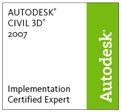Another release of AutoCAD always brings about uncertainty, doubt, and a lot of questions. There are firms who will adopt the new release and firms who haven't adopted a new release in 10 years. Out of all the questions I get when visiting with clients around release time is; "why does Autodesk release a new version of AutoCAD every year?" There are a hundred correct answers to that question. There are stock holders to keep happy, employees to pay, and all of the things that go along with operating a worldwide – publicly traded company. But on the other side of that coin is technology. Like it or not, technology drives our business, whether that business is civil engineering, architectural design, or the broad scope that is mechanical engineering; technology surrounds your every decision.
Take civil engineering for example. Current technology dictates what type of manhole is used in residential sub-divisions and erosion technology dictates how a site will be prepped and re-designed. These scenarios change over time – because technology changes. I'll bet you're glad that the washing machine was invented; otherwise, we'd still be scrubbing our clothes with a washboard.
The logical next step for this argument (or spirited debate) is to ask the question; would you still want to working on a drafting board? I've asked that question before and somebody always says yes. It never fails, somebody (who used to work on a board) says; "yes, I can work faster on a drafting board." The truth is, yes, the guy or gal who is still yearning for the feel of an electric eraser and t-square would probably be better off without CAD. They don't like it, they think they can't learn it or won't try, and they hate everything about CAD. Guess what, the drafting business – and more and more of the engineering business is CAD driven. If you walk into an office that still has a drafting board, it's either being used to store boxes or plots, or it's being used as a place to put a monitor and keyboard. The days of the drafting board are long gone. It's unfortunate for some, but that's the reality.
It seems like a huge disconnect to talk about drafting boards when you're looking at adoption rates of CAD software, but it's relative. When something new comes out, the folks who are against the change will kick and scream about it at first. Knowingly or unknowingly, willingly or unwillingly, at some point they will begin to use the new technology they were so against when it was new. Others however, will adopt new technology as soon as it's available. By the time the late adopters are learning it, the early adopters have moved on and the once new technology is just another tool in their belt, or palette if you will.
When Tool Palettes came along, I'm sure there were those out there (and probably still are) who didn't use them. Today, I would guess that 80% of AutoCAD users have made Tool Palettes a part of their workflow. Sheet Sets are probably not as widely adopted, but it's the same principal, they have grown in popularity over time and there are probably some who don't know what they ever did without them.
My point, finally, is that just because something is new doesn't mean it's bad. Sure you might struggle trying to tweak your workflow habits to incorporate a new tool and it might seem like its taking longer to use the new tool than the old ones. At first, that is to be expected. All CAD users go through that, it's called learning. But these new tools can help you become a better CAD user, more productive and ultimately save your company money. They may even help put more into your pocket.
Thanks for reading…
Denver





No comments:
Post a Comment